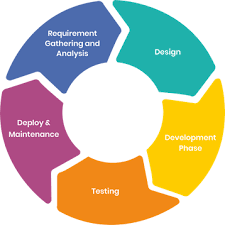Embarking on the Software Development Odyssey: A Comprehensive Introduction to the Art and Science of Crafting Digital Solutions

Introduction:
In the dynamic realm of technology, software development emerges as the catalyst propelling the evolution of digital landscapes. This comprehensive exploration delves into the multifaceted world of software development, unraveling its intricacies, methodologies, and the transformative impact it has on shaping our interconnected world. Whether you’re a novice embarking on the journey of code or a seasoned developer seeking a deeper understanding, this exploration promises to be an enlightening odyssey into the heart of software development.
I. Defining Software Development:
- What is Software Development?
- Software development is the systematic process of conceiving, designing, programming, testing, and maintaining software applications. It encompasses a creative and logical approach to solving real-world problems through the creation of digital solutions.
- The Role of Developers:
- Developers, also known as programmers or engineers, play a central role in software development. They translate concepts into code, bringing ideas to life through programming languages.
II. The Software Development Life Cycle (SDLC):
- Understanding SDLC:
- SDLC is a structured framework that outlines the stages involved in software development. Common phases include planning, design, implementation, testing, deployment, and maintenance.
- Agile Methodology:
- Agile is a popular iterative approach to software development. It emphasizes flexibility, collaboration, and continuous feedback, allowing teams to adapt to changing requirements.
- Waterfall Model:
- The Waterfall model is a traditional, linear approach to SDLC where each phase must be completed before moving on to the next. While less flexible than Agile, it provides a structured and sequential process.
III. Programming Languages and Tools:
- Popular Programming Languages:
- Software development is facilitated by a myriad of programming languages, each with its strengths and use cases. Examples include Python, Java, JavaScript, C++, and Ruby.
- Integrated Development Environments (IDEs):
- IDEs are software applications that provide comprehensive tools for software development. Examples include Visual Studio, Eclipse, and IntelliJ IDEA, streamlining coding, debugging, and testing.
IV. Core Concepts in Software Development:
- Algorithms and Data Structures:
- Algorithms are step-by-step procedures or formulas for solving problems, while data structures organize and store data for efficient retrieval. These fundamental concepts are crucial for designing efficient and scalable solutions.
- Object-Oriented Programming (OOP):
- OOP is a programming paradigm that uses objects – instances of classes – to structure code. Encapsulation, inheritance, and polymorphism are key principles in OOP.
- Version Control:
- Version control systems like Git enable developers to track changes, collaborate seamlessly, and revert to previous states of a codebase. GitHub and Bitbucket are popular platforms for hosting version-controlled projects.
V. Types of Software Development:
- Web Development:
- Web development focuses on creating websites and web applications. Front-end development involves user interfaces, while back-end development manages server-side logic and databases.
- Mobile App Development:
- Mobile app development targets creating applications for smartphones and tablets. iOS development uses languages like Swift, while Android development often involves Java or Kotlin.
- Desktop Application Development:
- Desktop applications are software programs designed to run on personal computers. Development may involve languages like Java, C#, or Python.
- Game Development:
- Game development involves creating interactive and immersive digital games. Game engines like Unity and Unreal Engine facilitate the creation of 2D and 3D games.
VI. Best Practices and Methodologies:
- Code Reviews:
- Code reviews involve collaborative examination of code to ensure quality, identify bugs, and share knowledge among team members.
- Unit Testing:
- Unit testing involves testing individual components or functions to ensure they behave as expected. Automated testing frameworks like JUnit and pytest aid in this process.
- Continuous Integration/Continuous Deployment (CI/CD):
- CI/CD pipelines automate the process of building, testing, and deploying code changes, ensuring a streamlined and efficient development workflow.
- Documentation:
- Documentation is essential for code maintainability and knowledge sharing. Well-documented code, API references, and user guides contribute to a project’s success.
VII. Challenges and Evolving Trends:
- Challenges in Software Development:
- Challenges include managing complexity, meeting tight deadlines, and adapting to rapidly changing technologies. Cybersecurity concerns and ethical considerations in AI development are also prominent challenges.
- Evolving Trends:
- Trends in software development include the rise of microservices architecture, serverless computing, and the integration of artificial intelligence and machine learning into applications.
VIII. Educational Paths and Career Opportunities:
- Educational Paths:
- Software development education can be pursued through traditional computer science degrees, coding bootcamps, online courses, and self-directed learning. Continuous learning is vital in this dynamic field.
- Career Opportunities:
- Career opportunities in software development encompass roles such as software engineer, front-end or back-end developer, full-stack developer, software architect, and quality assurance engineer.
IX. Conclusion:
Software development, as the heartbeat of technological progress, invites individuals into a world where creativity and logic converge to shape the future. This comprehensive guide has navigated the expansive terrain of software development, from its foundational principles to methodologies, languages, and evolving trends. Whether you are setting foot on the path of code for the first time or seeking to deepen your expertise, the journey into software development promises continual discovery and innovation. Embrace the challenges, celebrate the triumphs, and let your code be a testament to the boundless possibilities that unfold within the captivating realm of software development.




